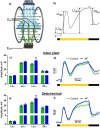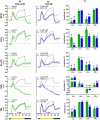Effect of extremely low-frequency magnetic fields on light-induced electric reactions in wheat
- PMID: 34994282
- PMCID: PMC9176247
- DOI: 10.1080/15592324.2021.2021664
Effect of extremely low-frequency magnetic fields on light-induced electric reactions in wheat
Abstract
Magnetic field oscillations resulting from atmospheric events could have an effect on growth and development of plants and on the responsive reactions of plants to other environmental factors. In the current work, extremely low-frequency magnetic field (14.3 Hz) was shown to modulate light-induced electric reactions of wheat (Triticum aestivum L.). Blue light-induced electric reaction in wheat leaf comprises depolarization and two waves of hyperpolarization resulting in an increase of the potential to a higher level compared to the dark one. Fluorescent and inhibitory analysis demonstrate a key role of calcium ions and calcium-dependent H+-ATPase of the plasma membrane in the development of the reaction. Activation of H+-ATPase by the increased calcium influx is suggested as a mechanism of the influence of magnetic field on light-induced electric reaction.
Keywords: Schumann resonance; calcium; extremely low frequency magnetic field; light-induced electric reactions; wheat.
Conflict of interest statement
No potential conflict of interest was reported by the author(s).
Figures





References
-
- Heckman SJ, Williams E, Boldi B.. Total global lightning inferred from Schumann resonance measurements. Journal of Geophysical Research: Atmospheres. 1998;103(D24):31775–9. doi:10.1029/98JD02648. - DOI
-
- Price C, Melnikov A. Diurnal, seasonal and inter-annual variations in the Schumann resonance parameters. J Atmos Sol Terr Phys. 2004;66(13–14):1179–1185. doi:10.1016/j.jastp.2004.05.004. - DOI
-
- Greenberg E, Price C. Diurnal variations of ELF transients and background noise in the Schumann resonance band. Radio Science. 2007;42(2):1–14. doi:10.1029/2006RS003477. - DOI
Publication types
MeSH terms
Substances
LinkOut - more resources
Full Text Sources
